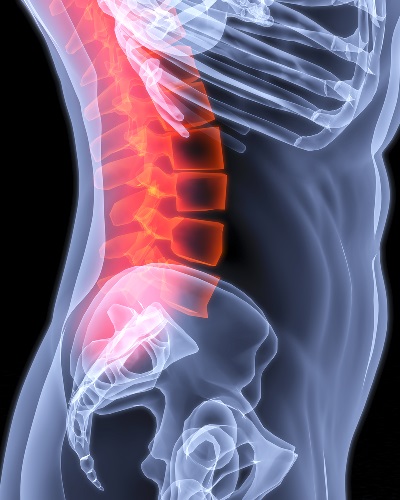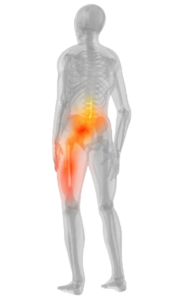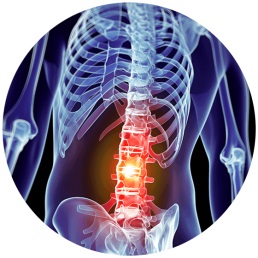Spondylolisthesis Symptoms & Treatment Options
Spondylolisthesis is a condition that occurs when one vertebra in the spine slides forward over the vertebra that sits beneath it. This most commonly occurs in the lumbar region of the spine, or the lower back. This spinal segment is more prone to slippage because it routinely participates in flexing, extending and rotating of the torso and also when lifting heaving objects. Although lumbar spondylolisthesis is most common, slippage can also occur in the cervical or thoracic spine.
The amount of vertebral slippage can occur at different grades or intensities. Your doctor may break down your condition into one of four grades based upon the severity of the movement. Grade 1 involves 1- 25% forward slippage, or movement that’s a quarter of the way off the front edge of the lower vertebrae. Similarly, Grade 2 involves26- 50% forward slippage; Grade 3 involves50-75% slippage; Grade 4 involves75- 100% slippage in relation to the neck vertebrae.
Symptoms of Spondylolisthesis
Spondylolisthesis can result in bone-on-bone contact or nerve and spinal cord compression. Depending upon the degree to which nerve function is disrupted, you may experience anywhere from mild to debilitating symptoms. On the other end of the spectrum, individuals with spondylolisthesis may experience no symptoms at all. Or, your symptoms may show up years later. Sometimes, the only way to identify if one has spondylolisthesis is to accidentally discover it during the course of an X-ray or an MRI that was taken to assess another spinal condition.
If you are experiencing any of these symptoms, please contact us to schedule an appointment.
Causes & Types of Spondylolisthesis
There is not simply one cause of spondylolisthesis, but rather, five main reasons why vertebral slippage may occur.
Congenital Spondylolisthesis is a condition that is present at birth and results in a defect in the facets joints. The facets are the joints connecting vertebrae that allow for spinal movements from side to side or forward and back. When these joints are incorrectly formed at birth, the facet joints are more prone to instability or fracture, which can cause spondylolisthesis.
Isthmic Spondylolisthesis is only slightly less common, and involves a defect in the part of the vertebra called the isthmus, or pars interarticularis. These pieces of bone connect the facet joints on the backside of our spine. The pars interarticularis is most prone to fracture in children between the ages of 5-7 years old, which often leads to pediatric or adolescent spondylolisthesis.
Degenerative Spondylolisthesis can occur as a result of the aging process as bones and spinal tissues lose their integrity over time. This condition is common. This degeneration is caused by the forces of gravity and the normal wear-and-tear that the spine accumulates over the years. Arthritis can play a factor in this degeneration. As our bones and tissues degrade, these degenerative processes leads to more chances for instability, friction, compression, and slippage.
Traumatic Spondylolisthesis occurs when an accident or sudden impact results in injury to the spine. Events such as car accidents, falls, and sports injuries can cause damage to spinal structures that may lead to vertebral slippage. Many athletes, even young children, can experience spondylolisthesis because of the quick-pivoting movements associated with sports such as gymnastics and football.
Pathologic Spondylolisthesis involves a disease or condition that leads to degeneration of the vertebrae. This can include spinal tumors or rheumatoid arthritis, both of which can lead to the progressive deterioration of spinal structures and tissues.
If You Or Someone You Know Is Experiencing Any Of The Symptoms Listed Below, You May Have Spondylolisthesis:
- A dull or intense pain, especially in the lower back or neck depending upon location of the slip.
- An increase in the visibility of lordosis or swayback.
- Pain, weakness, tingling, or the loss of sensation in one or both of the arms or thighs.
- Muscular tension in the hamstrings or lower back, with back spasms possible.
- A change in the way that person stands or walks, such as developing a waddling gait.
- A change in the position of the neck ( head tilted forward).
- Loss of control of the bladder or bowels. These symptoms require urgent attention.
More about Dr. Matin
Spondylolisthesis Symptoms & Treatment Options
Spondylolisthesis symptoms pain can be treated by Dr. Martin, give us a call to schedule an appointment.
We will provide different options of treatment.
Spinal Fusion Surgery
In advanced grades, spondylolisthesis can lead to high levels of spinal stenosis or narrowing to the spinal canal. Spinal fusions involve the mechanical fastening of vertebrae into place typically after decompression. For some, this type of surgery may be required in order to restore spinal stability or eliminate painful symptoms and relief nerve compression.
Spinal Decompression
Spondylolisthesis can also lead to spinal compression and damage to intervertebral discs or nerves. Along with a spinal fusion, your surgeon may perform a spinal decompression such as a laminectomy or foraminotomy to create additional room for the spinal cord and nerves.
Pain Management
Depending upon the degree of movement, pain can be a minor or major symptom of spondylolisthesis. For some, oral medications like acetaminophen and ibuprofen may be sufficient. For others, stronger prescription medications may be utilized as part of your treatment.
Other Therapies
Not all treatments for spondylolisthesis are operative: physical therapists can teach exercises or stretches to ease symptoms; chiropractors can adjust painful joints; and exercise or yoga instructors can help with increasing your muscular strength and spinal flexibility.






